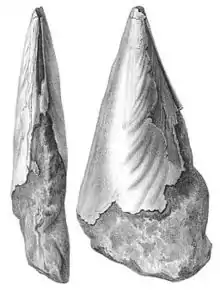Atrina pectinata
Atrina pectinata is a species of bivalves belonging to the family Pinnidae.[1]
| Atrina pectinata | |
|---|---|
 | |
| Scientific classification | |
| Domain: | Eukaryota |
| Kingdom: | Animalia |
| Phylum: | Mollusca |
| Class: | Bivalvia |
| Order: | Pteriida |
| Family: | Pinnidae |
| Genus: | Atrina |
| Species: | A. pectinata |
| Binomial name | |
| Atrina pectinata (Linnaeus, 1767) | |
The species is found in the Old World.[1] They are important in commercial fishing in Asia. They have the common name of kijogae [pen shells].[2] A. pectinata is a sedentary long-lived species that lives up to 7 years.[3]
Appearance
A. pectinata are patchy with small clusters.[4] They are commonly called kijogae [pen shells] due to their resemblance to a traditional Korean tool.[4] There are two physical morphs of A. pectinata: scaly and smooth, as a result of how the shells develop.[5] Recent research suggests that the two morphs are different enough for them to be taxonomically distinguishable.[5]
Distribution
A. pectinata is widely located in the Indo-West Pacific.[4] The shellfish is an inhabitant of muddy or sandy surfaces.[4] In Korea, the shellfish is located in ocean depths of 20 to 50 m in muddy areas.[4] In the Bohai Sea and Yellow Sea off the coast of China, it is found at habitats ranging from the subtidal zone to depths of 100m.[3] The specific locations of pen shell in Korean waters are the south seashore of Yeojaman, the west seashore of Boryeong and the Taean.[4]
In Japan, large numbers of A. pectinata were traditionally found off the southwestern coast, with commercial activity centered around Kyushu Island.[2]
Development
A suspension study of A. pectinata showed that in artificial habitats, gonad development occurred at the same time for both male and female pen shells and corresponded to warming water temperatures and increased food availability.[5] A. pectinata is a broadcast spawner with external fertilization.[3] Spawning occurs after gonad development during the period from May to September and expended gonads are ejected in the fall.[5] Spawning is often triggered by environmental cues such as temperature.[3] 1.6% of spawning individuals are hermaphroditic.[5] A. pectinata has a pelagic larval phase that lasts about 30 days and mean fecundities of 29 million eggs per year, which suggests high dispersal potential.[3]
Conservation
A. pectinata population has decreased rapidly since 1990 as a result of overfishing, habitat loss from coastal development, pollution, etc.[4] It is a popular food source and is commercially important to a number of countries which makes it a great interest to fisheries.[6] However, an effort to preserve this species has been made by aquaculture development.[4] This species serves as a commercial value, especially in the country of Korea.[4] It serves great purpose in Korean fisheries.[4] The shellfish was also desired for its taste for several years before its decline in the 1990s.[4]
A. pectinata mortality events in 2003 and 2004 reveal that the southwestern Japan population suffered from necrosis in their gills and kidneys not caused by known pathogenic agents.[2] The presence of particles resembling viral matter in the necrotic tissue may hint at an unknown viral agent that can trigger mass mortality events.[2] These mass mortality events are a part of a long decline in the population off the southern coast of Japan.
In an effort to conserve the shellfish species, microsatellite markers have been used to access the genetic variability and differentiation of A. pectinata.[4] Only one finding has shown that microsatellite markers were able to find genetic differentiation among the wild and hatchery population in Korea.[4] However, more sources need to confirm the genetic information and diversity of the pen shell in order to conserve the species.[4]
References
- "Atrina pectinata (Linnaeus, 1767)". www.gbif.org. Retrieved 18 October 2021.
- Maeno, Yukio; Yurimoto, Tatsuya; Nasu, Hiroshi; Ito, Shiro; Aishima, Noboru; Matsuyama, Tomomasa; Kamaishi, Takashi; Oseko, Norihisa; Watanabe, Yasunori (25 July 2006). "Virus-like particles associated with mass mortalities of the pen shell Atrina pectinata in Japan" (PDF). Diseases of Aquatic Organisms. 71: 169–173. doi:10.3354/dao071169. ISSN 1616-1580. Retrieved 6 March 2022.
- Xue, Dong-Xiu; Wang, Hai-Yan; Zhang, Tao; Liu, Jin-Xian (2014-05-01). "Population Genetic Structure and Demographic History of Atrina pectinata Based on Mitochondrial DNA and Microsatellite Markers". PLoS ONE. 9 (5): e95436. doi:10.1371/journal.pone.0095436. ISSN 1932-6203. PMC 4006771.
- An, Hye Suck; Lee, Jang Wook; Dong, Chun Mae (2012-12-01). "Population genetic structure of Korean pen shell (Atrina pectinata) in Korea inferred from microsatellite marker analysis". Genes & Genomics. 34 (6): 681–688. doi:10.1007/s13258-012-0091-z. ISSN 2092-9293.
- Maeno, Yukio; Suzuki, Kengo; Yurimoto, Tatsuya; Fuseya, Reiko; Kiyomoto, Setsuo; Ohashi, Satoshi; Oniki, Hiroshi (August 2009). "Maturation Process of Broodstock of the Pen ShellAtrina pectinata(Linnaeus, 1767) in Suspension Culture". Journal of Shellfish Research. 28 (3): 561–568. doi:10.2983/035.028.0319. ISSN 0730-8000.
- LIU, JUN; LI, QI; KONG, LINGFENG; ZHENG, XIAODONG (2011-09-16). "Cryptic diversity in the pen shell Atrina pectinata (Bivalvia: Pinnidae): high divergence and hybridization revealed by molecular and morphological data". Molecular Ecology. 20 (20): 4332–4345. doi:10.1111/j.1365-294x.2011.05275.x. ISSN 0962-1083.